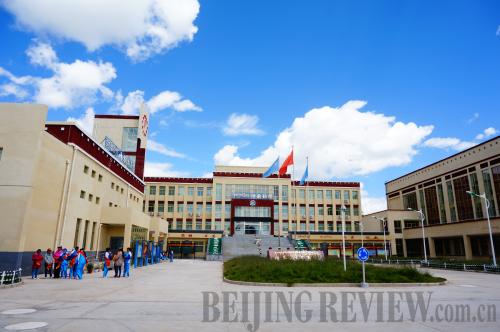|
 |
|
EDUCATION ASSISTANCE: Zhejiang Middle School in Nagqu Prefecture, Tibet Autonomous Region, is named after east China's Zhejiang Province, which helped fund it (ZENG WENHUI) |
Tibetan resident Dorjee, 63, is pleased with his new home. Last September, he moved into the 200-square-meter property located in Zhejiang Residential Compound in Nagqu Prefecture, Tibet Autonomous Region. This August, the area was battered by a heavy torrential rain. Yet his house, along with other new ones in his neighborhood, survived the storm unscathed, while quite a number of old adobe houses not yet renovated were literally washed out.
The new houses, built with aid from China's eastern Zhejiang Province, were designed to resist magnitude-8 earthquakes. Dorjee is a low-income resident receiving a minimum living allowance from the government. He was granted a total of 85,000 yuan ($13,600) in subsidies for tearing down his old adobe house and replacing it with the new one.
"To be able to live in such a fine house, I am very grateful to the government for carrying out the paired assistance project," he said.
In 1994, the State Council made the strategic decision to extend paired assistance to Tibet. Under the policy, economically developed provinces were required to pair up with Tibetan counties, cities or prefectures and support local development.
In the past two decades, 17 central and eastern provinces and municipalities, and 17 state-owned enterprises as well as government ministries have carried out more than 7,600 assistance projects, and sent 5,965 cadres in seven batches to work in Tibet. The focus of the aid used to be on infrastructure construction such as paving roads and erecting bridges. Now it has been shifted toward education, healthcare and other initiatives to boost farmers and herders' income and increase their livelihoods.
Paired assistance projects have spurred economic growth in the autonomous region. According to official statistics, Tibet's GDP surged from 5.61 billion yuan ($913.31 million) in 1995 to 80.2 billion yuan ($13 billion) in 2013 after a 13-fold growth.
Accessible education
Thirteen-year-old Gunxujua is a student at Zhejiang Middle School in Nagqu Prefecture. During the summer holiday, he usually returns to his hometown in Qinghai Province with his father or goes to Shannan and Xigaze prefectures to pay religious homage.
He will enter senior high school in two years. Talking about his future plans, he said he hopes to be lucky enough to be admitted into a senior high school recruiting Tibetan students in central and eastern parts of China.
The Zhejiang Middle School in Nagqu is a junior high school constructed with more than 76 million yuan ($12.37 million) from the Zhejiang Provincial Government. It was officially opened on August 20, 2013. Currently, 568 students are enrolled in the school, 70-80 percent of whom are children of Tibetan farmers and herders.
Logden, a 32-year-old Tibetan music teacher, serves as the school's headmaster. He said that the school is a good choice for local residents because it is affordable, well-equipped and has teaching quality close to that of schools in other parts of China. As a result, this year, a good number of students in Nagqu who were admitted by junior middle schools in central and east China eventually chose Zhejiang Middle School instead.
The school gives children an opportunity to receive quality education without leaving their hometown. "Although most of the children leaving their parents at such young age to study in more developed areas of China can grow up well, some students are not accustomed to the climate and diet there. Besides, without the company of their parents, they may suffer psychologically," said Logden.
But he confessed that currently some teachers in the school have not received adequate training, and the school's advanced equipment has not been used efficiently either. He said that the school plans to send some teachers to receive training out of the region and invite teachers there to teach in his school.
| 